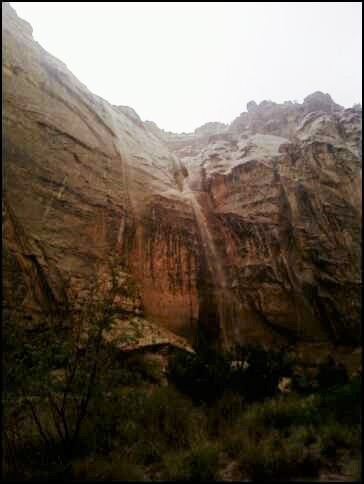
Capitol Gorge during Flash Flood
The lightning flashed in the dark night sky — bursts of light illuminating the Flatiron mountains. We couldn’t tell exactly where the series of thunderstorms were but figured we would encounter them somewhere along Boulder Canyon on our drive home to Nederland. We didn’t have to wait long.
Immediately upon entering the mouth of the canyon, large drops of rain hit the windshield – plop, plop, plop. Then the rain started to come down at a furious rate. Bryon turned the windshielder wipers to high – whir, whir, whir. Still we could barely see the road in front of us. The driver towing the trailer in front of us drove erratically, suddenly braking and weaving around the road. What was he doing?
Suddenly we realized the reason for his erratic driving — mud, debris and water were flowing over the road. Flash flood! Oh my God, what to do now? Instinctively, I wanted the car to drive faster, to get out of this dangerous situation, to get out of the canyon. I became infuriated with the truck towing the trailer — get out of our way! However, we knew there wasn’t a road that left the steep-sided canyon until the Sugarloaf turn off.
Many a driver has made that same gamble and lost. Signs posted along Boulder Canyon warn of flooding — “Climb high during flooding”. It only takes 6 inches of rushing flood waters to knock a person or even a car from its path. Six inches is not that much, and from what we had seen it looked like that threshold had already been met. At what point, do you stop trying to outrun the flood, park it, abandon the car and try to scale the steep hillside?
This was not my first western experience with flash flooding or flooding even. Working in Capitol Reef National Park in 2009, I had witnessed a few flash floods, but none more scary than an afternoon in Capitol Gorge. Being covered in sedimentary rock, namely sandstone, it doesn’t take much rain to fall in a short amount of time to create flash flooding, even a quarter to half inch of rain can produce flooding. The sandstone is porous so doesn’t absorb much water at all, it simply runs down the cliffs and pools in washes that crisscross the gorges.
One afternoon, I had driven the popular Scenic Drive into Capitol Gorge, a strikingly beautiful steep-walled gorge of various colors of sandstone. At the time I drove in and started to hike, it seemed sunny and pleasant. On my way back from hike, dark clouds started to move overhead. I commented to visitors that were walking with me that we should hustle as a thunderstorm would create flooding. Fortunately, we made it to our cars before the storm unleashed a torrent of rain.
It was only two miles to the an elevated paved parking lot outside the canyon so I thought it wouldn’t be a problem to at least get there. But water began pouring off the cliffs in muddy waterfalls within seconds after I had gotten into my car. Before I knew it, huge streams of water seemingly appeared out of nowhere, rushing across the road. I became panicked, feeling like I had to drive as fast as possible to get out of there. Get out of here! GET OUT OF HERE! was the mantra that ran through my head. Time seemed suspended, as those two miles seemed so much longer.
In truth, the situation had become so dire I should have just pulled the car to the side, and climbed up some rocks to make sure I was safe. Fortunately, my U.S. government truck made it through the rushing flood water to the paved parking area and I was safe. But no one else was behind me. I called Park Dispatch to let them know people were trapped in the gorge.
Strangely, the vagaries of weather were such that the visitor center, a mere 8 miles away had barely gotten any rain. The thunderstorm passed within 30 minutes, and the waters receded so that all the visitors were able to get out eventually.
But the memory of how fast a flood could appear and threaten my safety, throwing me into a panic left an indelible impression on me. Last night was a reminder of that. Flash floods are part of mountain living because there are so many canyon roads between the mountains and the towns below. It’s not a matter of if, but when.


Very scary! We were in Manitou Springs a few years ago during a flash flood. I’ll never forget it.